Synthesis and Characterization of UV-Curable Resin with High Refractive Index for a Luminance-Enhancing Prism Film
Abstract
1. Introduction
2. Materials and Methods
2.1. Materials
2.2. Synthesis of BPEF-DMP
2.3. Preparation of Prism Replica Mold
2.4. Preparation of Prism Film
2.5. Characterization and Instruments
2.5.1. Analysis of the Chemical Structure of BPEF-DMP
2.5.2. Characterization of Compositions
2.5.3. Characterization of Prism Films
3. Results and Discussion
3.1. Chemical Structure of BPEF-DMP
3.2. Compositions for Prism Film
3.2.1. Preparation and Characterization of the Composition
3.2.2. Mechanical Properties of the Film
3.2.3. Thermal Properties of the Film
3.3. Fabrication and Characterization of the Prism Film
3.3.1. Geometrical Properties of the Prism Film
3.3.2. Physical Properties
3.3.3. Optical Properties
4. Conclusions
Supplementary Materials
Author Contributions
Funding
Institutional Review Board Statement
Informed Consent Statement
Data Availability Statement
Conflicts of Interest
References
- Alfaro, E.; Lloret, T.; Vilardy, J.M.; Bastidas, M.; Morales-Vidal, M.; Pascual, I. Photopolymer holographic lenses for solar energy applications: A review. Polymers 2024, 16, 732–755. [Google Scholar] [CrossRef] [PubMed]
- Alim, M.D.; Glugla, D.J.; Mavila, S.; Wang, C.; Nystrom, P.D.; Sullivan, A.C.; McLeod, R.R.; Bowman, C.N. High dynamic range (Δn) two-stage photopolymers via enhanced solubility of a high refractive index acrylate writing monomer. ACS Appl. Mater. Interfaces 2018, 10, 1217–1224. [Google Scholar] [CrossRef] [PubMed]
- Tang, Y.; Pina-Hernandez, C.; Niu, Q.; Nie, J.; Cabrini, S. A novel high-refractive index episulfide-thiol polymer for nanoimprinting optical elements. J. Mater. Chem. C 2018, 6, 8823–8831. [Google Scholar] [CrossRef]
- Lee, J.; Son, J.; Lim, J.; Kim, I.; Kim, S.; Cho, N.; Choi, W.; Shin, D. Transformer-based mechanical property prediction for polymer matrix composites. Korean J. Chem. Eng. 2024, 41, 3005–3018. [Google Scholar] [CrossRef]
- Higashihara, T.; Ueda, M. Recent progress in high refractive index polymers. Macromolecules 2015, 48, 1915–1929. [Google Scholar] [CrossRef]
- Wei, Q.; Pötzsch, R.; Komber, H.; Pospiech, D.; Voit, B. High refractive index hyperbranched polymers with different naphthalene contents prepared through thiol-yne click reaction using di-substituted asymmetric bulky alkynes. Polymers 2014, 55, 5600–5607. [Google Scholar] [CrossRef]
- Griebel, J.J.; Namnabat, S.; Kim, E.T.; Himmelhuber, R.; Moronta, D.H.; Chung, W.J.; Simmonds, A.G.; Kim, K.J.; Van Der Laan, J.; Nguyen, N.A. New infrared transmitting material via inverse vulcanization of elemental sulfur to prepare high refractive index polymers. Adv. Mater. 2014, 26, 3014–3018. [Google Scholar] [CrossRef]
- Okuda, H.; Koyama, Y.; Kojima, T.; Takata, T. 9,9-Diaryl-4,5-diazafluorene-based cardo polymer: Synthesis and characteristic properties. J. Polym. Sci. A Polym. Chem. 2013, 51, 4541–4549. [Google Scholar] [CrossRef]
- Mazumder, K.; Voit, B.; Banerjee, S.A. Recent Progress in Sulfur-Containing High Refractive Index Polymers for Optical Applications. ACS Omega 2024, 9, 6253–6279. [Google Scholar] [CrossRef]
- Kim, J.-S.; Cho, B.-S.; Kweon, J.-O.; Noh, S.-T. Preparation and properties of UV-curable di-functional sulfur-containing thioacrylate and thiourethane acrylate monomers with high refractive indices. Prog. Org. Coat. 2014, 77, 1695–1700. [Google Scholar] [CrossRef]
- Ando, S.; Fujigaya, T.; Ueda, M. Density functional theory calculations of photoabsorption spectra of organic molecules in the vacuum ultraviolet region. Jpn. J. Appl. Phys. 2002, 41, 105. [Google Scholar] [CrossRef]
- Dou, Z.; Sun, J.; Fang, Q. A Facile One-Step Conversion of Biobased Magnolol (Honokiol) toward High Refractive Materials. Biomacromolecules 2024, 25, 6155–6163. [Google Scholar] [CrossRef]
- You, N.-H.; Higashihara, T.; Oishi, Y.; Ando, S.; Ueda, M. Highly refractive poly (phenylene thioether) containing triazine unit. Macromolecules 2010, 43, 4613–4615. [Google Scholar] [CrossRef]
- Pavel, F.M.; Mackay, R.A. Reverse micellar synthesis of a nanoparticle/polymer composite. Langmuir 2000, 16, 8568–8574. [Google Scholar] [CrossRef]
- Hung, C.-H.; Whang, W.-T. Effect of surface stabilization of nanoparticles on luminescent characteristics in ZnO/poly (hydroxyethyl methacrylate) nanohybrid films. J. Mater. Chem. 2005, 15, 267–274. [Google Scholar] [CrossRef]
- Manshina, A.A.; Tumkin, I.I.; Khairullina, E.M.; Mizoshiri, M.; Ostendorf, A.; Kulinich, S.A.; Makarov, S.; Kuchmizhak, A.A.; Gurevich, E.L. The Second laser revolution in chemistry: Emerging laser technologies for precise fabrication of multifunctional nanomaterials and nanostructures. Adv. Funct. Mater. 2024, 34, 2405457. [Google Scholar] [CrossRef]
- Matsuda, T.; Funae, Y.; Yoshida, M.; Yamamoto, T.; Takaya, T. Optical material of high refractive index resin composed of sulfur-containing aromatic methacrylates. J. Appl. Polym. Sci. 2000, 76, 50–54. [Google Scholar] [CrossRef]
- Song, J.H.; Hong, S.M.; Park, S.K.; Kwon, H.K.; Hwang, S.H.; Oh, J.M.; Koo, S.M.; Lee, G.; Park, C. Synthesis and characterization of hyperbranched thiol hardener and their curing behavior in thiol–epoxy. Macromol. Res. 2024. [CrossRef]
- Gaina, C.; Gaina, V. Polyethers and polythioethers containing 1, 4-dithiin-2, 3; 5, 6-tetrayl diimide. Des. Monomers Polym. 2005, 8, 347–363. [Google Scholar] [CrossRef]
- Robb, M.J.; Knauss, D.M. Poly (arylene sulfide)s by nucleophilic aromatic substitution polymerization of 2, 7-difluorothianthrene. J. Polym. Sci. A Polym. Chem. 2009, 47, 2453–2461. [Google Scholar] [CrossRef]
- Okutsu, R.; Suzuki, Y.; Ando, S.; Ueda, M. Poly (thioether sulfone) with high refractive index and high Abbe’s number. Macromolecules 2008, 41, 6165–6168. [Google Scholar] [CrossRef]
- Nebioglu, A.; Leon, J.A.; Khudyakov, I.V. New UV-curable high refractive index oligomers. Ind. Eng. Chem. Res. 2008, 47, 2155–2159. [Google Scholar] [CrossRef]
- Nakayama, N.; Hayashi, T. Synthesis of novel UV-curable difunctional thiourethane methacrylate and studies on organic–inorganic nanocomposite hard coatings for high refractive index plastic lenses. Prog. Org. Coat. 2008, 62, 274–284. [Google Scholar] [CrossRef]
- Fukuzaki, N.; Higashihara, T.; Ando, S.; Ueda, M. Synthesis and characterization of highly refractive polyimides derived from thiophene-containing aromatic diamines and aromatic dianhydrides. Macromolecules 2010, 43, 1836–1843. [Google Scholar] [CrossRef]
- Qin, D.; Xia, Y.; Whitesides, G.M. Soft lithography for micro-and nanoscale patterning. Nat. Protoc. 2010, 5, 491. [Google Scholar] [CrossRef]
- Xia, Y.; Whitesides, G.M. Soft lithography. Annu. Rev. Mater. Sci. 1998, 28, 153–184. [Google Scholar] [CrossRef]
- ASTM D3359; Standard Test Methods for Rating Adhesion by Tape Test. ASTM International: West Conshohocken, PA, USA, 2023.
- Lu, H.; Carioscia, J.A.; Stansbury, J.W.; Bowman, C.N. Investigations of step-growth thiol-ene polymerizations for novel dental restoratives. Dent. Mater. 2005, 21, 1129–1136. [Google Scholar] [CrossRef]
- Chiou, B.-S.; Khan, S.A. Real-time FTIR and in situ rheological studies on the UV curing kinetics of thiol-ene polymers. Macromolecules 1997, 30, 7322–7328. [Google Scholar] [CrossRef]
- Yu, J.; Ma, G.; Li, P.; Ling, L.; Wang, B. Preparation of multifunctional thiol- and acrylate-terminated polyurethane: A comparative study on their properties in UV-curable coatings. J. Appl. Polym. Sci. 2014, 131, 40740–40741. [Google Scholar] [CrossRef]
- de Melo Monteiro, G.Q.; Montes, M.A.J.R.; Rolim, T.V.; de Oliveira Mota, C.C.B.; Kyotoku, B.d.B.C.; Gomes, A.S.L.; de Freitas, A.Z. Alternative methods for determining shrinkage in restorative resin composites. Dent. Mater. 2011, 27, 176–185. [Google Scholar] [CrossRef]
- Ortiz, R.A.; Urbina, B.A.P.; Valdez, L.V.C.; Duarte, L.B.; Santos, R.G.; Valdez, A.E.G.; Soucek, M.D. Effect of introducing a cationic system into a thiol-ene photopolymerizable formulation. J. Polym. Sci. A Polym. Chem. 2007, 45, 4829–4843. [Google Scholar] [CrossRef]
- Hong, S.M.; Ann, J.N.; Kim, K.Y. UV-Curable Resin Composition for Forming Prism Layer of a Prism Film or a Prism Functional Complex Film, the Prism Film and the Liquid Crystalline Device Employing the Same. KR Patent 10-1465260, 19 November 2014. [Google Scholar]
- Hong, S.M.; Kim, K.Y.; Kim, T.U. UV-Curable Resin Composition, Prism Sheet of the Same, and Backlight Unit and Liquid Crystal Display Device Using the Sheet. KR Patent 10-1194553, 18 February 2012. [Google Scholar]
- Hong, S.C.; Jung, H.S.; Jang, Y.O.; Choi, M.C. Thermoplastic Elastomer Composition Comprising Polyamide and Method for Preparing the Same. KR Patent 10-1423609, 21 July 2014. [Google Scholar]
- Fisher, R.A. Design of Experiments. Br. Med. J. 1936, 1, 554. [Google Scholar] [CrossRef]

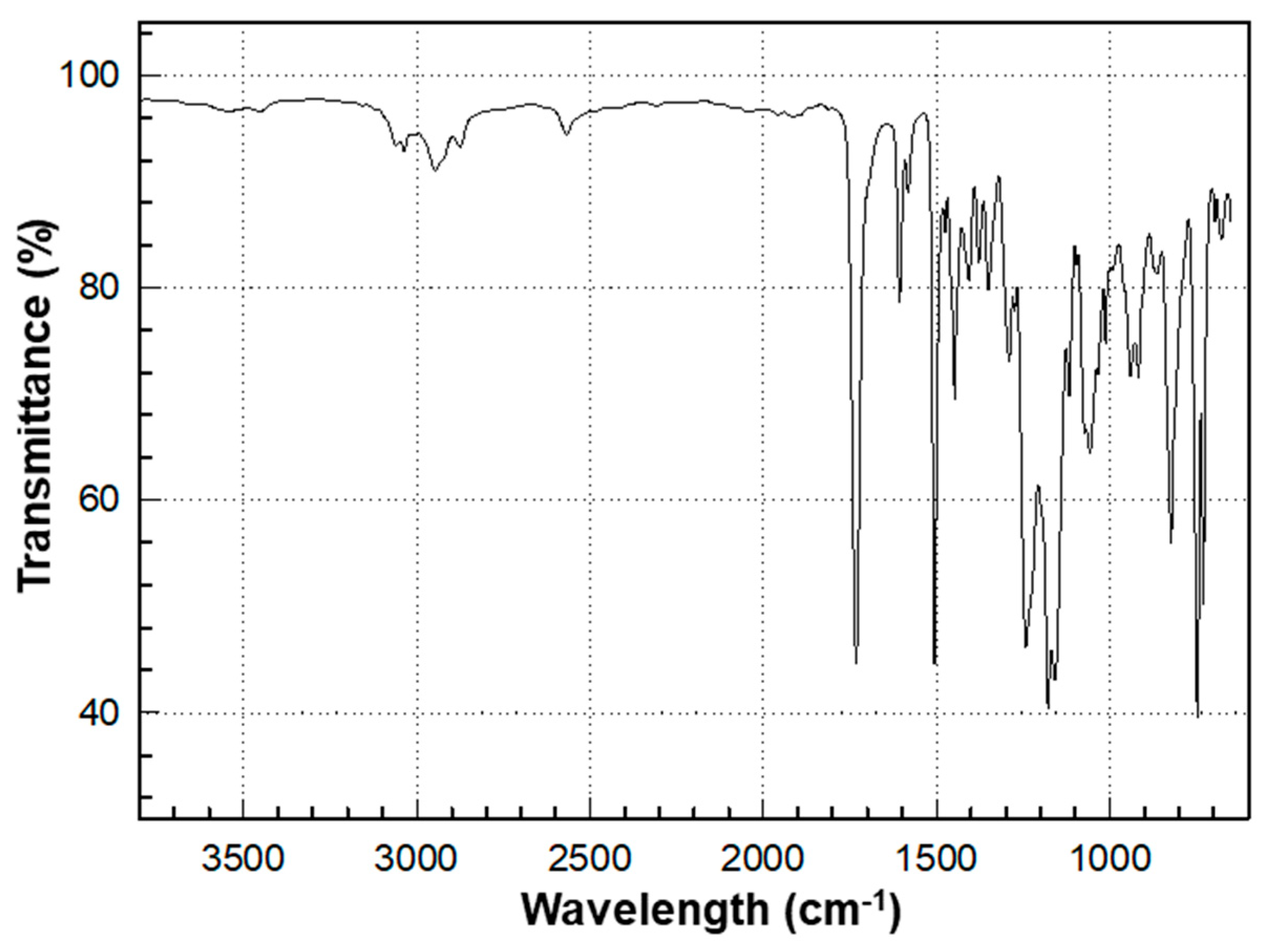

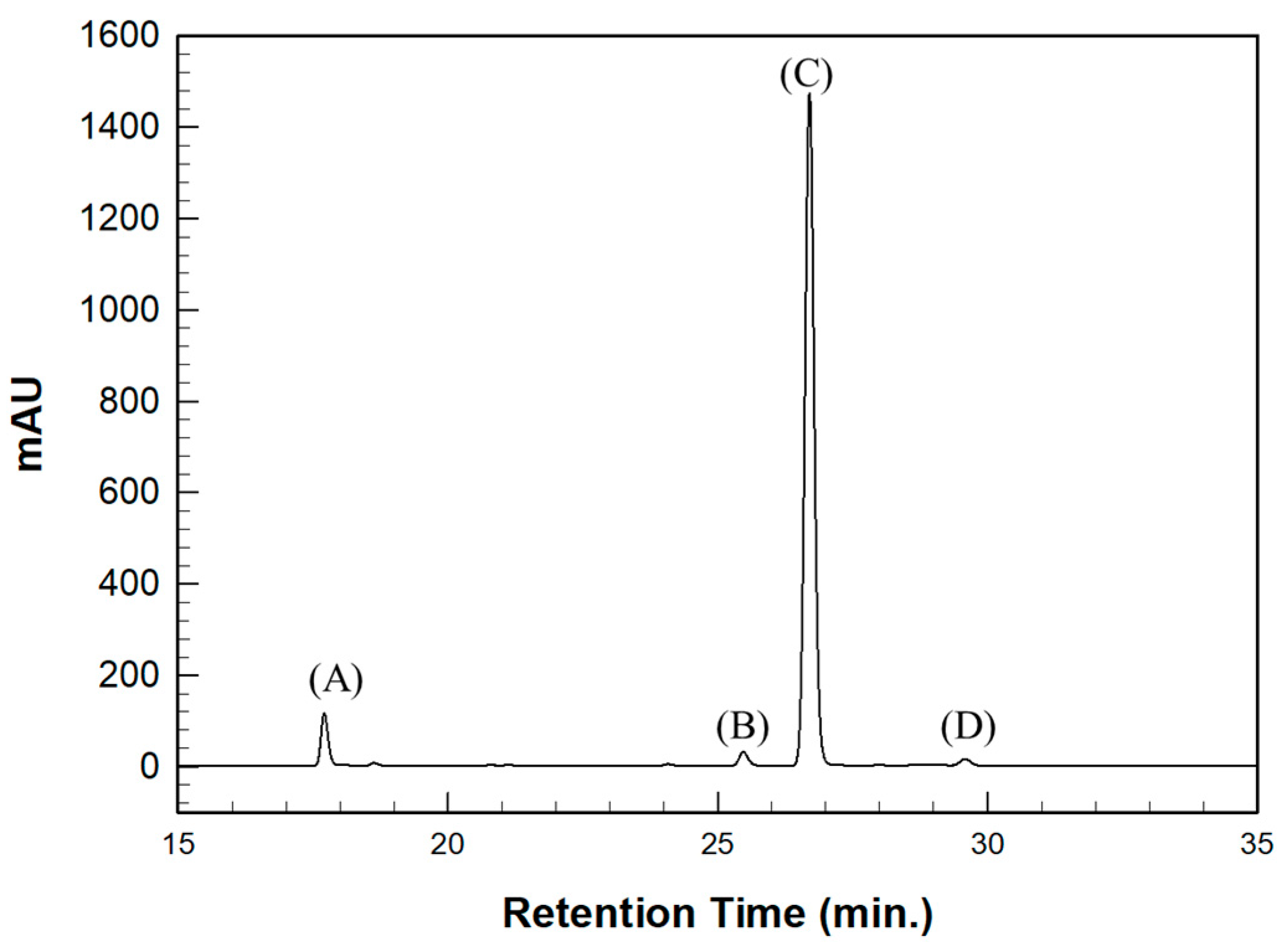
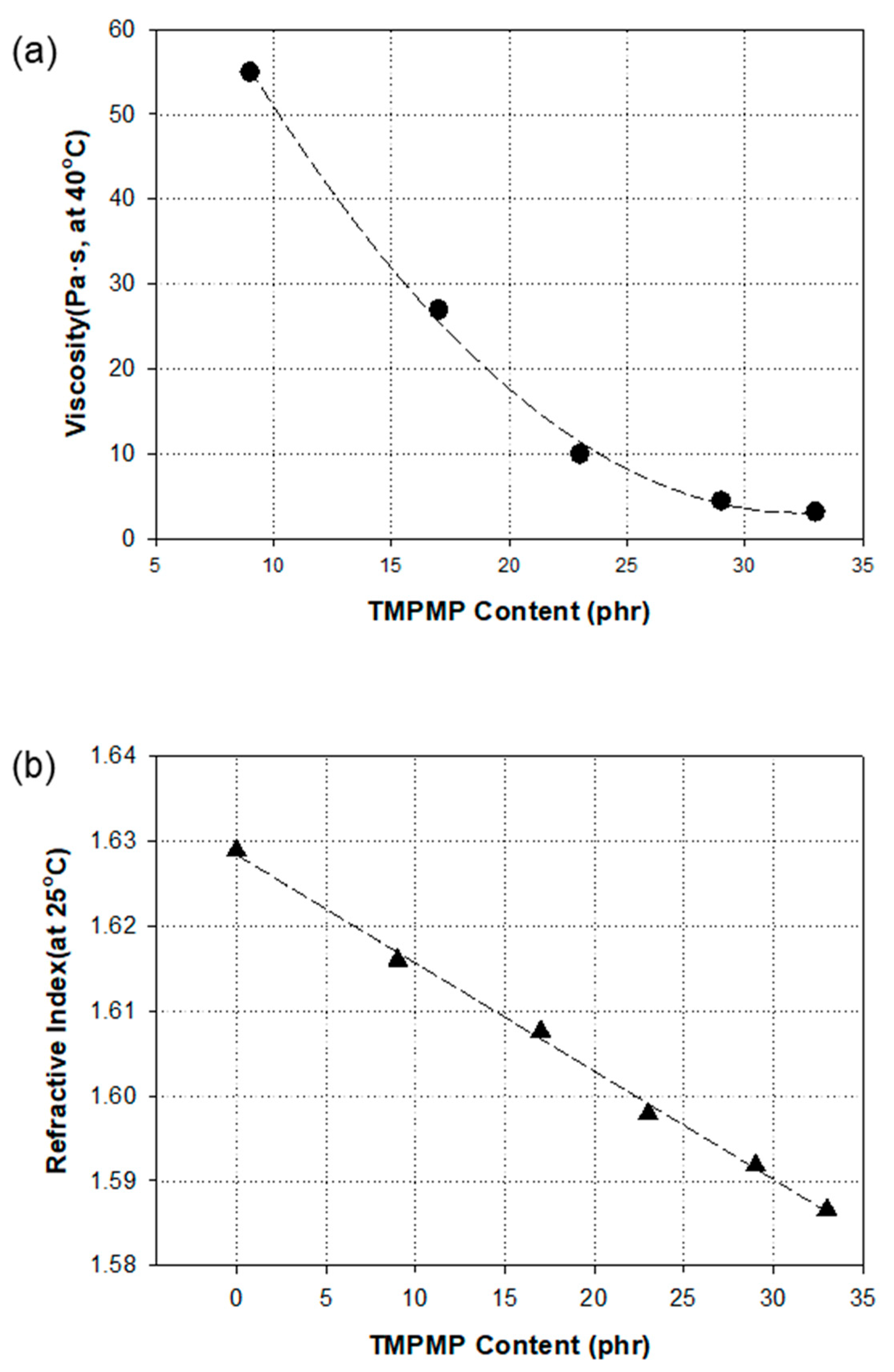

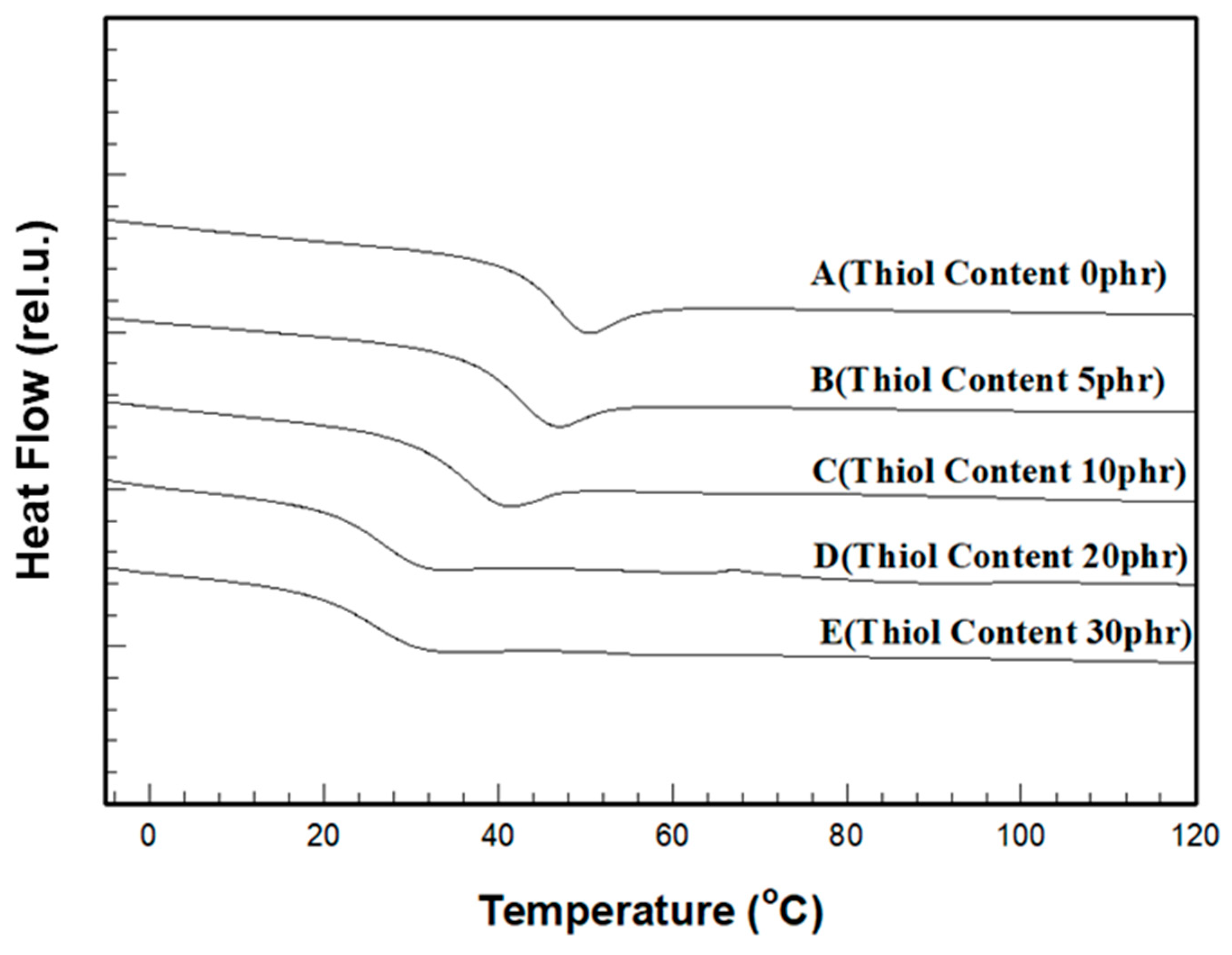
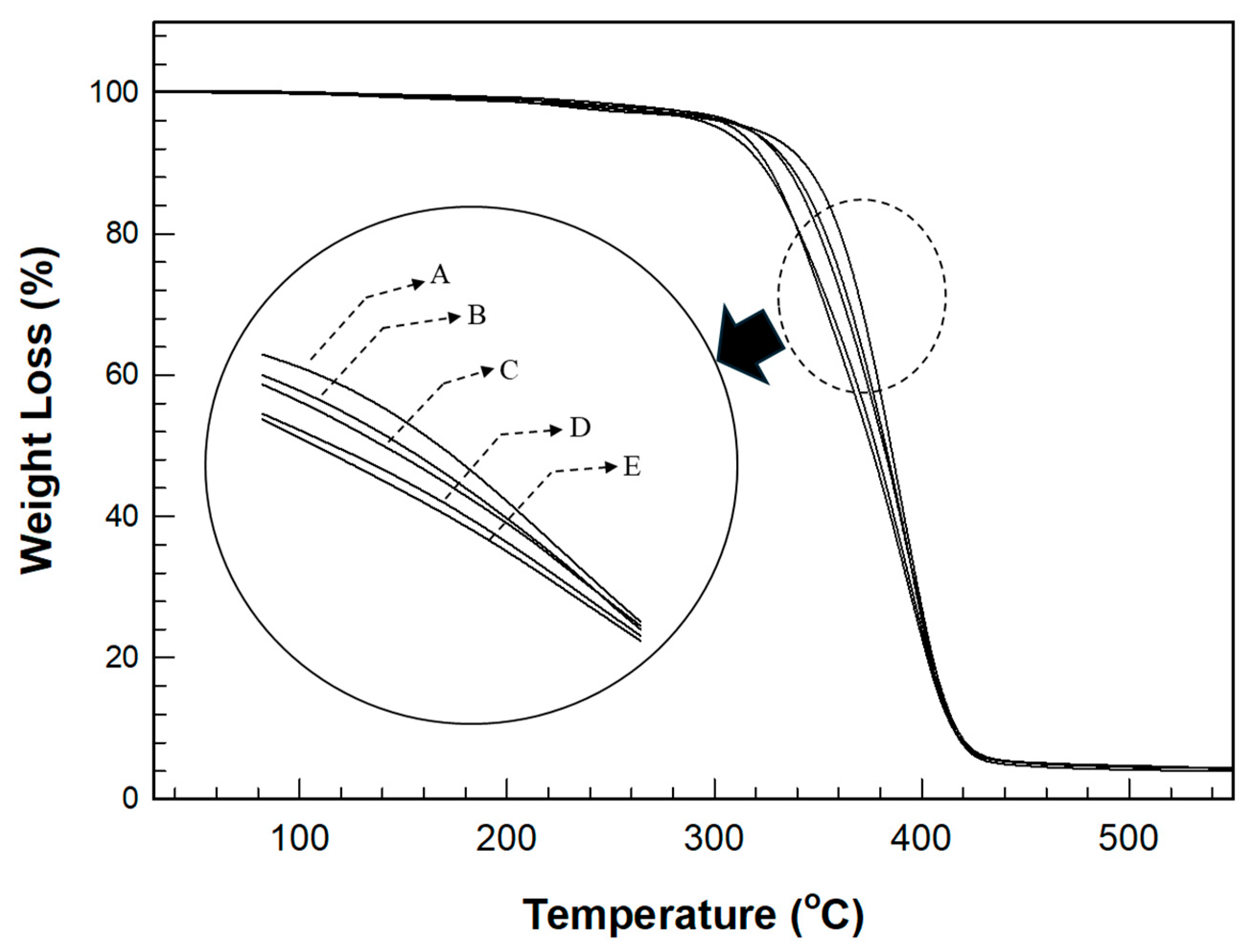
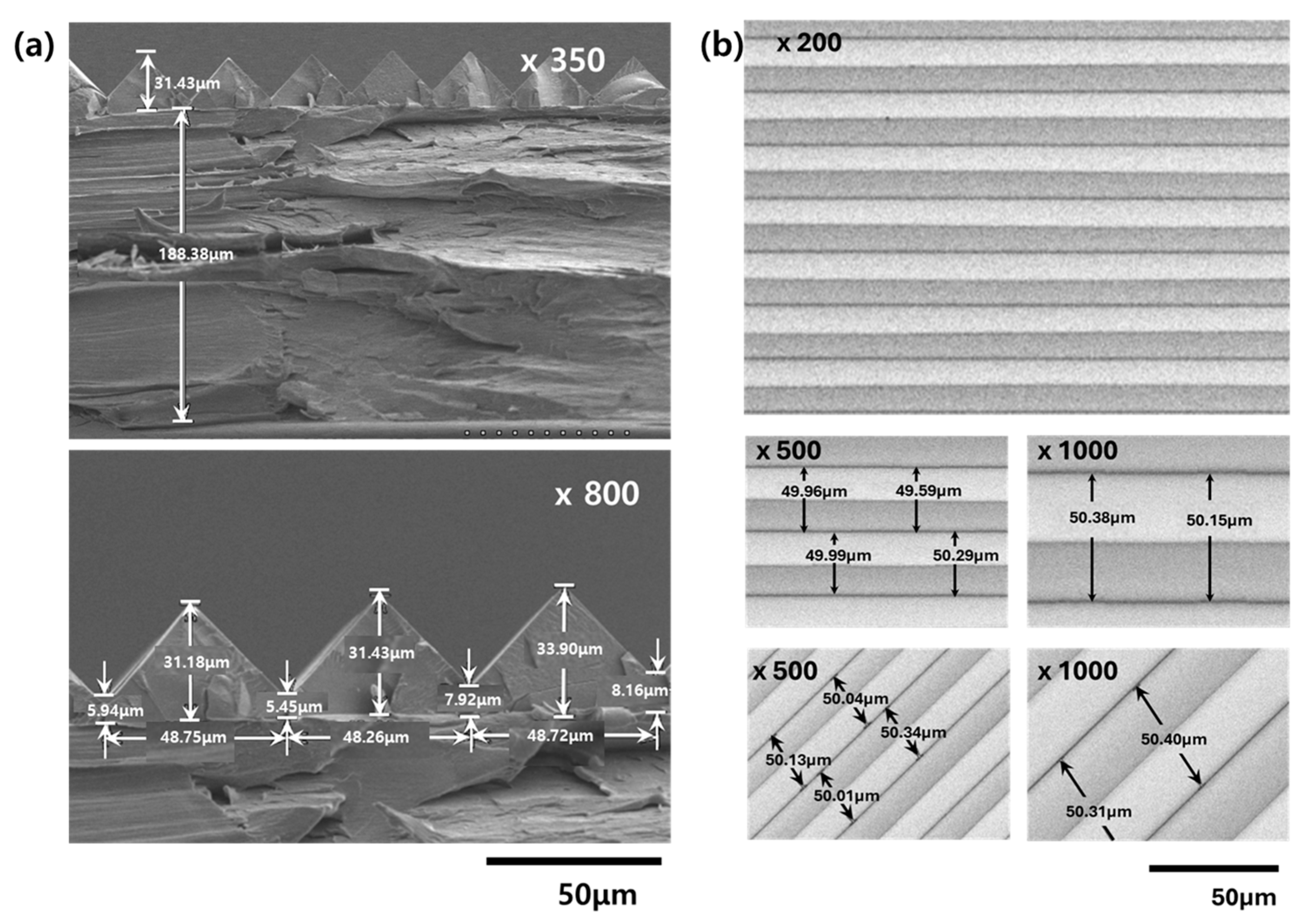

| Chemical Structure | Classification | |
|---|---|---|
| (a) |  | Unreacted product |
| (b) |  | Unreacted product and over-reaction |
| (c) |  | Target product |
| (d) |  | Over-reaction |
| Ingredients | Composition of Mixtures | ||||
|---|---|---|---|---|---|
| A | B | C | D | E | |
| Thiol * (g) | 0 | 5.0 | 10.0 | 20.0 | 30.0 |
| BPEF-EDA (g) | 60.0 | 60.0 | 60.0 | 60.0 | 60.0 |
| BZA (g) | 38.0 | 38.0 | 38.0 | 38.0 | 38.0 |
| TPO (g) | 2.0 | 2.0 | 2.0 | 2.0 | 2.0 |
| Entry | Density | Shrinkage (%) | |
|---|---|---|---|
| Before Cure | After Cure | ||
| A | 1.1442 | 1.2369 | 7.495 |
| B | 1.1521 | 1.2321 | 6.493 |
| C | 1.1604 | 1.2262 | 5.366 |
| D | 1.1712 | 1.2191 | 3.929 |
| E | 1.1902 | 1.2154 | 2.073 |
| Entry | DSC Analysis | TGA Analysis | ||
|---|---|---|---|---|
| Tgo (°C) (1) | Tgm (°C) (2) | Td10 (°C) (3) | Td50 (°C) (4) | |
| A | 41.88 | 44.02 | 385.01 | 427.21 |
| B | 36.03 | 39.22 | 377.62 | 425.01 |
| C | 29.71 | 33.79 | 375.60 | 424.12 |
| D | 20.60 | 25.83 | 366.29 | 421.43 |
| E | 19.01 | 25.04 | 363.51 | 419.30 |
| Entry | Polarizer Film Haze (%) | |||
|---|---|---|---|---|
| 5 | 15 | 25 | 30 | |
| A | 500 g | 100 g | 50 g | 30 g |
| B | 800 g | 200 g | 200 g | 50 g |
| C | 1000 g | 500 g | 300 g | 100 g |
| D | 1400 g | 800 g | 400 g | 200 g |
| E | 1800 g | 1000 g | 800 g | 400 g |
| Entry | Color Coordination | Luminance | |
|---|---|---|---|
| △x | △y | △L (%) | |
| A | Reference | Reference | Reference |
| B | 1/1000 | 1/1000 | 100.98 |
| C | 2/1000 | 3/1000 | 102.44 |
| D | 2/1000 | 3/1000 | 103.08 |
| E | 2/1000 | 4/1000 | 103.96 |
Disclaimer/Publisher’s Note: The statements, opinions and data contained in all publications are solely those of the individual author(s) and contributor(s) and not of MDPI and/or the editor(s). MDPI and/or the editor(s) disclaim responsibility for any injury to people or property resulting from any ideas, methods, instructions or products referred to in the content. |
© 2024 by the authors. Licensee MDPI, Basel, Switzerland. This article is an open access article distributed under the terms and conditions of the Creative Commons Attribution (CC BY) license (https://creativecommons.org/licenses/by/4.0/).
Share and Cite
Song, J.H.; Hong, S.-M.; Park, S.K.; Kwon, H.K.; Hwang, S.-H.; Oh, J.-M.; Koo, S.-M.; Lee, G.; Park, C. Synthesis and Characterization of UV-Curable Resin with High Refractive Index for a Luminance-Enhancing Prism Film. Polymers 2025, 17, 76. https://doi.org/10.3390/polym17010076
Song JH, Hong S-M, Park SK, Kwon HK, Hwang S-H, Oh J-M, Koo S-M, Lee G, Park C. Synthesis and Characterization of UV-Curable Resin with High Refractive Index for a Luminance-Enhancing Prism Film. Polymers. 2025; 17(1):76. https://doi.org/10.3390/polym17010076
Chicago/Turabian StyleSong, Jin Han, Seung-Mo Hong, Seok Kyu Park, Hyeok Ki Kwon, Seok-Ho Hwang, Jong-Min Oh, Sang-Mo Koo, Giwon Lee, and Chulhwan Park. 2025. "Synthesis and Characterization of UV-Curable Resin with High Refractive Index for a Luminance-Enhancing Prism Film" Polymers 17, no. 1: 76. https://doi.org/10.3390/polym17010076
APA StyleSong, J. H., Hong, S.-M., Park, S. K., Kwon, H. K., Hwang, S.-H., Oh, J.-M., Koo, S.-M., Lee, G., & Park, C. (2025). Synthesis and Characterization of UV-Curable Resin with High Refractive Index for a Luminance-Enhancing Prism Film. Polymers, 17(1), 76. https://doi.org/10.3390/polym17010076






